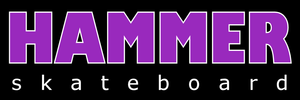Out of the Box Basic Tips For Beginners
SAFETY - If you wear full safety gear, you can avoid most of the common scrapes and minor injuries that occur in an aggressive activity like skateboarding.
But safety gear or not: VEHICLES AND SKATEBOARDING DO NOT MIX!
Skate in a park or schoolyard that is closed off to vehicles. Check our Toronto Skatepark Info HERE.
Wear shoes - not sandals, flipflops or Crocs. (Skating barefoot is also not advisable).
ADJUSTING YOUR BOARD - Everyone likes their board to turn a bit differently. If your new board feels pretty good when you stand on it, then just leave it as is. But if you think it feels too stiff or wobbly, loosen or tighten the trucks. ("Truck" definition: The 2 metal parts holding your wheels on your board). Use a skate wrench, available HERE, or socket or adjustable wrench on the main largest nuts in the middle of the 2 trucks. (Turn left to loosen, right to tighten.) Remember not to loosen the kingpin nut too much. Once the nut is flush (even) with the top of the kingpin bolt, that is as loose as it should safely go.
WHICH IS THE FRONT OF THE BOARD? - It is not always obvious, unless you have graphic grip tape, or a top to bottom board graphic, or different coloured mounting hardware. Don't think about it too much. On a regular street board, the front (nose) of your board is only about 1/2 inch longer than the back (tail). So it doesn't matter much, especially at first.
WHICH WAY TO STAND? - You will either be naturally comfortable skating with your right foot on the front of the board, or the left. (The population is split pretty much evenly.) If you don't know which you are, try this experiment: Stand on the ground, naturally, legs apart (without your board!). Have someone push you from behind (just hard enough to knock you off balance). You will naturally plant one of your feet forward to recover your balance from that push. Whichever foot you planted forward, that is probably how you will ride your skateboard.
BALANCING - Now grab your board, and go somewhere flat. (You can do this on grass if you don't want to roll at all).
If you chose Left foot forward: Put the board down to the left of you. Place your left foot on the front of the board, in the area where you can see the 4 truck bolts. (At first, it is best to avoid stepping on the kicked up parts of the board on the nose or tail.) Keep your right foot on the ground, to the right, close to the back of the board. Now move your back foot onto the back of the board (place it somewhere in the area where you can see the 4 back truck bolts).
If you chose Right foot forward: Put the board down to the right of you. Place your right foot on the front of the board, in the area where you can see the 4 truck bolts. (At first, it is best to avoid stepping on the kicked up parts of the board on the nose or tail.) Keep your left foot on the ground, to the left, close to the back of the board. Now move your back foot onto the back of the board (place it somewhere in the area where you can see the 4 back truck bolts).
You should be standing, balancing on the board. Get a feel for that. Now, leave your front foot on the board, and take off your back foot and put it back on the ground. Do that Off/On Off/On a few times until you feel balanced. Once you are comfortable standing with both feet on board, try pivoting your feet a bit so that you stand more perpendicular with the long edges of the board. That will give you more control & leverage. (This will become a habit. While pushing, you normally keep your front foot straight up & down the board. But once both feet are on, you will learn to instantly pivot them so that they are more perpendicular.)
ROLLING - Now you need to roll a bit. (So if you are on grass, get onto some flat concrete or pavement. No slopes or hills or cars!) Set up the same way, but start with a little push from your back foot. Go slowly. As soon as you start rolling, get your back foot on to the board and balance yourself. You should then be able to take the back foot off and put it on the ground to stop. Off/On Off/On. As you push more and roll further, you can take that back foot off, and drag it when you need to stop. Pushing with your back foot will give you a stable stance to balance on. Braking with your back foot is a good way to learn how to control your speed.
Once you have your balance and can push a bit, learn how to turn gradually, by leaning either right or left. The rest is up to you. The possibilities are almost endless...
That should get you skating for now. Enjoy your new board! For further tips on adjusting and maintaining your board, please check out Hammer's Beginner Guide To Maintenance HERE.
-- thanks for reading, Dave Buchanan.
